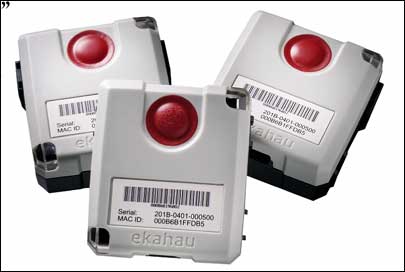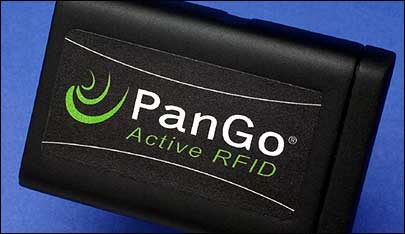The battery-powered tag transmits a signal at regular intervals, or it is woken up by a signal from the interrogator when it gets into read range and then begins beeping. But some end users have been reluctant to invest in proprietary systems requiring the installation of a lot of interrogators that need to be networked, powered and maintained. Now companies can use active real-time locating systems (RTLSs) that take advantage of equipment already installed—their Wi-Fi network.
Developers of active RFID RTLS systems have begun making tags that transmit in the 2.45 GHz band, using the IEEE 802.11 air-interface protocol, or Wi-Fi. Because the Wi-Fi RFID tags can send data to access points being used in the end user’s wireless local area network, there’s no need to install proprietary interrogators to collect tag data. This lowers infrastructure costs and simplifies deployment.
The systems can be used anywhere that Wi-Fi access points are located or can be installed. Wi-Fi RTLS has been adopted by automotive and manufacturing companies, where proprietary RTLS systems have dominated, and mining companies are using the systems to track high-value equipment inside mines. But the health-care industry is the biggest adopter of the systems, because large-scale wireless LAN deployments already exist and the assets to be tracked are high in value. “That’s important, since the tags themselves cost around $50 to $60,” says Gemma Tedesco, an analyst with In-Stat, which projects that shipments of Wi-Fi tags could meet 2 million in 2010.
Three companies are competing for the Wi-Fi RFID pie: AeroScout, Ekahau and PanGo Networks. Each sells tags that collect the tag data from Wi-Fi access points and uses software algorithms to ascertain the tag’s location. The location data is typically displayed in real time through a 2-D or 3-D map of the monitored area.

Providers of proprietary RTLS do much the same thing. WhereNet, for example, sells location sensors that transmit tag data in the 2.45 GHz band, using the American National Standards Institute 371.1 protocol. But companies that use the tags must install WhereNet’s WhereLAN location sensors (interrogators) in the facilities where they want to track goods. On the upside, the tags have a longer read range than Wi-Fi tags, and their signals are less prone to interference from metallic objects.
But Wi-Fi RFID may soon become even more attractive. G2 Microsystems recently announced a Wi-Fi chipset built for active tags, which consumes less battery power than the chips currently used, so tags could be easier to maintain. And G2 is selling the chipset for as low as $12 each in large orders, which should lead to a drop in the price of finished tags. Ekahau and PanGo are building the G2 chipset into their next generation of products.
Who’s Who in Wi-Fi RFID
AeroScout: www.aeroscout.com, 650-571-0800
Ekahau: www.ekahau.com, 866-435-2428
PanGo Networks: www.pangonetworks.com, 508-626-8900
G2 Microsystems: www.g2microsystems.com, 408-626-4812


